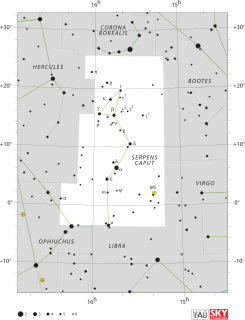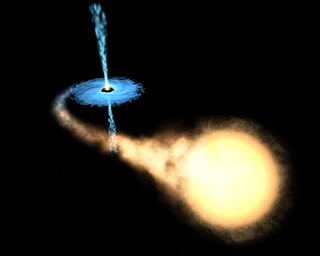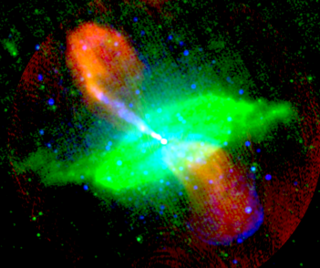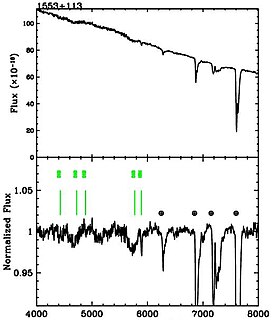
A quasar is an extremely luminous active galactic nucleus (AGN), powered by a supermassive black hole, with mass ranging from millions to tens of billions of solar masses, surrounded by a gaseous accretion disc. Gas in the disc falling towards the black hole heats up because of friction and releases energy in the form of electromagnetic radiation. The radiant energy of quasars is enormous; the most powerful quasars have luminosities thousands of times greater than that of a galaxy such as the Milky Way. Usually, quasars are categorized as a subclass of the more general category of AGN. The redshifts of quasars are of cosmological origin.

Serpens is a constellation in the northern celestial hemisphere. One of the 48 constellations listed by the 2nd-century astronomer Ptolemy, it remains one of the 88 modern constellations designated by the International Astronomical Union. It is unique among the modern constellations in being split into two non-contiguous parts, Serpens Caput to the west and Serpens Cauda to the east. Between these two halves lies the constellation of Ophiuchus, the "Serpent-Bearer". In figurative representations, the body of the serpent is represented as passing behind Ophiuchus between Mu Serpentis in Serpens Caput and Nu Serpentis in Serpens Cauda.
An active galactic nucleus (AGN) is a compact region at the center of a galaxy that has a much-higher-than-normal luminosity over at least some portion of the electromagnetic spectrum with characteristics indicating that the luminosity is not produced by stars. Such excess non-stellar emission has been observed in the radio, microwave, infrared, optical, ultra-violet, X-ray and gamma ray wavebands. A galaxy hosting an AGN is called an "active galaxy". The non-stellar radiation from an AGN is theorized to result from the accretion of matter by a supermassive black hole at the center of its host galaxy.

X-ray binaries are a class of binary stars that are luminous in X-rays. The X-rays are produced by matter falling from one component, called the donor, to the other component, called the accretor, which is very compact: a neutron star or black hole. The infalling matter releases gravitational potential energy, up to several tenths of its rest mass, as X-rays. The lifetime and the mass-transfer rate in an X-ray binary depends on the evolutionary status of the donor star, the mass ratio between the stellar components, and their orbital separation.

3C 273 is a quasar located in the constellation of Virgo. It was the first quasar ever to be identified.

Seyfert galaxies are one of the two largest groups of active galaxies, along with quasars. They have quasar-like nuclei with very high surface brightnesses whose spectra reveal strong, high-ionisation emission lines, but unlike quasars, their host galaxies are clearly detectable.

A non-standard cosmology is any physical cosmological model of the universe that was, or still is, proposed as an alternative to the then-current standard model of cosmology. The term non-standard is applied to any theory that does not conform to the scientific consensus. Because the term depends on the prevailing consensus, the meaning of the term changes over time. For example, hot dark matter would not have been considered non-standard in 1990, but would be in 2010. Conversely, a non-zero cosmological constant resulting in an accelerating universe would have been considered non-standard in 1990, but is part of the standard cosmology in 2010.

A radio galaxy is a galaxy with giant regions of radio emission extending well beyond its visible structure. These energetic radio lobes are powered by jets from its active galactic nucleus. They have luminousities at radio wavelengths up to 1039 W between 10 MHz and 100 GHz. The radio emission is due to the synchrotron process. The observed structure in radio emission is determined by the interaction between twin jets and the external medium, modified by the effects of relativistic beaming. The host galaxies are almost exclusively large elliptical galaxies. Radio-loud active galaxies can be detected at large distances, making them valuable tools for observational cosmology. Recently, much work has been done on the effects of these objects on the intergalactic medium, particularly in galaxy groups and clusters.

A blazar is an active galactic nucleus (AGN) with a relativistic jet directed very nearly towards an observer. Relativistic beaming of electromagnetic radiation from the jet makes blazars appear much brighter than they would be if the jet were pointed in a direction away from Earth. Blazars are powerful sources of emission across the electromagnetic spectrum and are observed to be sources of high-energy gamma ray photons. Blazars are highly variable sources, often undergoing rapid and dramatic fluctuations in brightness on short timescales. Some blazar jets exhibit apparent superluminal motion, another consequence of material in the jet traveling toward the observer at nearly the speed of light.

A BL Lacertae object or BL Lac object is a type of active galactic nucleus (AGN) or a galaxy with such an AGN, named after its prototype, BL Lacertae. In contrast to other types of active galactic nuclei, BL Lacs are characterized by rapid and large-amplitude flux variability and significant optical polarization. Because of these properties, the prototype of the class was originally thought to be a variable star. When compared to the more luminous active nuclei (quasars) with strong emission lines, BL Lac objects have spectra dominated by a relatively featureless non-thermal emission continuum over the entire electromagnetic range. This lack of spectral lines historically hindered identification of the nature and distance of such objects.

3C 279 is an optically violent variable quasar (OVV), which is known in the astronomical community for its variations in the visible, radio and x-ray bands. The quasar was observed to have undergone a period of extreme activity from 1987 until 1991. The Rosemary Hill Observatory (RHO) started observing 3C 279 in 1971, the object was further observed by the Compton Gamma Ray Observatory in 1991, when it was unexpectedly discovered to be one of the brightest gamma ray objects in the sky. It is also one of the brightest and most variable sources in the gamma ray sky monitored by the Fermi Space Telescope. It was used as a calibrator source for Event Horizon Telescope observations of M87* that resulted in the first image of a black hole.

Halton Christian "Chip" Arp was an American astronomer. He was known for his 1966 Atlas of Peculiar Galaxies, which catalogues many examples of interacting and merging galaxies, though Arp disputed the idea, claiming apparent associations were prime examples of ejections. Arp was also known as a critic of the Big Bang theory and for advocating a non-standard cosmology incorporating intrinsic redshift.
QSR J1819+3845 is a quasar notable for being the most variable known extragalactic radio source. This quasar shows variations of factors of four or more on a timescale of hours.
A dark galaxy is a hypothesized galaxy with no, or very few, stars. They received their name because they have no visible stars, but may be detectable if they contain significant amounts of gas. Astronomers have long theorized the existence of dark galaxies, but there are no confirmed examples to date. Dark galaxies are distinct from intergalactic gas clouds caused by galactic tidal interactions, since these gas clouds do not contain dark matter, so they do not technically qualify as galaxies. Distinguishing between intergalactic gas clouds and galaxies is difficult; most candidate dark galaxies turn out to be tidal gas clouds. The best candidate dark galaxies to date include HI1225+01, AGC229385, and numerous gas clouds detected in studies of quasars.

3C 454.3 is a blazar located away from the galactic plane. It is one of the brightest gamma ray sources in the sky, and is one of the most luminous astronomical object ever observed, with a maximum absolute magnitude of -31.4. It has the brightest blazar gamma ray flare recorded, twice as bright as the Vela Pulsar in the Milky Way galaxy. It also flares at radio and visible wavelengths – in red light, the blazar brightened by more than 2.5 times to magnitude 13.7 – and it is very bright at high radio frequencies.
CTA 102, also known by its B1950 coordinates as 2230+114 and its J2000 coordinates as J2232+1143, is a blazar-type quasar discovered in the early 1960s by a radio survey carried out by the California Institute of Technology. It has been observed by a large range of instruments since its discovery, including WMAP, EGRET, GALEX, VSOP and Parkes, and has been regularly imaged by the Very Long Baseline Array since 1995. It has also been detected in gamma rays, and a gamma-ray flare has been detected from it.

S5 0014+81 is a distant, compact, hyperluminous, broad-absorption-line quasar, or blazar, located near the high declination region of the constellation Cepheus, near the North Equatorial Pole.

NGC 7469 is an intermediate spiral galaxy in the constellation of Pegasus. NGC 7469 is located about 200 million light years away from Earth, which means, given its apparent dimensions, that NGC 7469 is approximately 90,000 light years across. It was discovered by William Herschel on November 12, 1784.

NGC 5728 is an active barred spiral galaxy located 146 million light years away in the southern constellation of Libra. It was discovered on May 7, 1787 by William Herschel. The designation comes from the New General Catalogue of J. L. E. Dreyer, published in 1888. It has an apparent visual magnitude of 13.40 and spans an angle of 3.4 arcminutes. The galaxy shows a red shift of 0.00935 and has a heliocentric radial velocity of 2,803 km/s. It has an estimated mass of 72 billion times the mass of the Sun and stretches around 30 kpc across.

The Teacup galaxy, also known as the Teacup AGN or SDSS J1430+1339 is a low redshift type 2 quasar, showing an extended loop of ionized gas resembling a handle of a teacup, which was discovered by volunteers of the Galaxy Zoo project and labeled as a Voorwerpje.

















